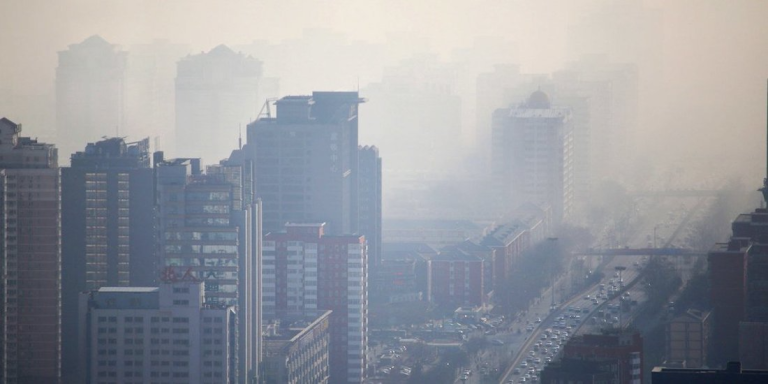
Living Beneath the Haze: Examining the Devastating Human Cost and Complex Fight Against China’s Capital’s Smog Crisis
New York, N.Y. – Imagine stepping outside and tasting the air. Not the crisp bite of winter or the humid thickness of summer, but a gritty, acrid tang that coats the tongue and scratches the throat.
Imagine a sky perpetually drained of blue, replaced by a featureless, oppressive gray that blurs skyscrapers just blocks away. This isn’t a dystopian fiction; it’s the daily reality for millions inhabiting Beijing and other major Chinese metropolises, where smog has transcended mere nuisance to become a defining, deadly public health catastrophe.
The Anatomy of an Atmospheric Assault
Beijing’s smog isn’t random weather; it’s a complex chemical soup brewed from specific ingredients under particular conditions. Primary components include particulate matter, especially the insidious PM2.5 – microscopic particles smaller than 2.5 micrometers that penetrate deep into the lungs and even enter the bloodstream.
These particles originate predominantly from the combustion of fossil fuels: coal-fired power plants providing electricity and heat, vehicle emissions from the city’s vast traffic network, and industrial processes. Secondary pollutants form when these primary emissions react in the atmosphere under sunlight, creating ozone and other harmful compounds.
Geographic factors exacerbate the problem; Beijing sits in a basin surrounded by mountains, creating frequent temperature inversions that trap pollutants close to the ground, preventing dispersion. Seasonal weather patterns, particularly stagnant air in winter when coal heating peaks, turn the city into a vast, suffocating pollution chamber.
The Silent Scourge: Health Impacts Unmasked
The human cost of breathing Beijing’s air is staggering and well-documented by epidemiological studies.
PM2.5 exposure is conclusively linked to a dramatic increase in respiratory diseases like asthma, bronchitis, and chronic obstructive pulmonary disease (COPD). It severely impacts cardiovascular health, contributing to heart attacks, strokes, and hypertension.
Alarmingly, the damage extends to cognitive function, with studies suggesting links to reduced cognitive performance in adults and impaired neurological development in children. T
he most vulnerable populations – children, the elderly, and those with pre-existing conditions – bear the brunt. Cancer risks, particularly lung cancer, rise significantly with prolonged exposure.
The World Health Organization (WHO) consistently ranks air pollution as one of the top global health risks, with cities like Beijing experiencing mortality rates substantially higher than global averages directly attributable to poor air quality. Emergency room visits surge during severe smog episodes.
Beyond Lungs: Economic and Social Reverberations
The smog crisis permeates every facet of life, imposing heavy economic and social tolls. Healthcare systems strain under the burden of pollution-related illnesses, diverting vast resources. Worker productivity plummets due to illness and the cognitive fog associated with high pollution days.
Tourism suffers as iconic landmarks like the Forbidden City or the Great Wall vanish behind the haze, deterring visitors. Daily routines are dictated by air quality index (AQI) readings; schools cancel outdoor activities, construction halts, and citizens retreat indoors, relying on expensive air purifiers.
The constant visibility of the problem, the need for face masks, and the pervasive worry about health create a profound psychological burden – a low-grade, chronic anxiety about the very air one breathes.
Real estate values fluctuate with AQI forecasts, and businesses face operational disruptions. The societal fabric frays under this persistent environmental stress.
Navigating the Haze: Responses and the Long Road Ahead
Recognizing the severity, the Chinese government, particularly since around 2013, has implemented aggressive, albeit sometimes unevenly enforced, air pollution control measures.
These include: drastically reducing coal consumption within the city and relocating heavy industry; implementing stricter vehicle emission standards and promoting electric vehicles (EVs); expanding public transportation networks like the subway; massive investments in renewable energy sources like solar and wind power; and deploying sophisticated air quality monitoring systems with real-time public data.
These efforts have yielded measurable, though fragile, improvements; annual average PM2.5 concentrations in Beijing have decreased significantly from their peak.
However, challenges remain immense: balancing economic growth with environmental protection, ensuring consistent policy enforcement across regions, managing the sheer scale of energy demand, and addressing transboundary pollution drifting from industrial areas outside the capital.
Technological innovation in pollution control and clean energy is crucial, but so is sustained political will and international cooperation. The battle for clean air is far from won.
Audio Summary (75 words): Beijing’s suffocating smog, a toxic mix from coal, traffic, and industry trapped by geography, poses a dire health emergency. PM2.5 particles invade lungs and bloodstream, causing respiratory and heart disease, cancer, and cognitive harm. Beyond health, it cripples economies and daily life. While aggressive government measures show progress—reducing coal, boosting renewables, enforcing standards—the path to truly clean air demands sustained innovation, unwavering policy commitment, and global collaboration against a persistent, deadly haze.